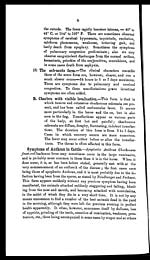Medicine - Veterinary > Civil Veterinary Departments > Civil Veterinary Department ledger series I-VI > Volume II - Anthrax
(109) Page 7
Download files
Individual page:
Thumbnail gallery: Grid view | List view

7
Œdematous swellings often occur, either localized or diffuse and
more or less extensive, penetrating into the interstices between the
muscles, and appearing ordinarily in the neighbourhood of the point of
the inoculation or of the absorption, or even at other parts of the
body.
In certain cases, subcutaneous tumefactions, more or less voluminous,
appear, either as the result of traumatism, or without apparent cause,
and these rapidly increase in extent. These tumors appear in various
regions—under the arms, throat, in front of the shoulders, prepectoral
and prescapular lymphatic glands, under the chest, belly, on the sheath,
scrotum, etc., also on the legs. They are at first hot and rather painful,
and afterwards become cool. When incised we find them to be formed
of a yellow fluid or a semigelatiniform material with a black centre of
uncoagulated or partially coagulated blood; they contain bacilli, their
appearance is due to congestion of the connective tissue, which is accom-
panied by exudation, vascular ruptures or hæmorrhages. They may be
distinguished from the similar swellings which occur in charbon symp-
tomatique by the act of their being noncrepitant. The form of charbon
in which these swellings or œdemata are noticed is that which has been
designated "charbon with visible localization;" "carbuncular fever,"
black variola, etc., and they are observed more particularly in the horse.
The duration of the malady varies from three to seven days, and the
cases of recovery are more numerous than are those in the other forms.
Forms of Anthrax.—Having given a more or less minute detail of
the general symptoms of anthrax in its various forms, I will now
give a résumé of the divisions adopted by Friedberger and Frohner.
They divide the disease firstly into A, Charbon without visible localiza-
tion; and B, Charbon with visible localization.
A is divided into (1)—The suracute form, known by the
names of charbonous apoplexy, apoplectic charbon, an-
thrax acutissimas. The symptomatology is that of cere-
bral apoplexy. The animal is suddenly attacked, stum-
bles, and falls to the ground; sanguinolent discharges issue
from the mouth and anus. The animal perishes amidst
convulsions at the end of a period varying from a few
minutes to an hour or more. Animals are very often
found dead in the stable. This form is most commonly
observed in the sheep and ox, and is most frequently
met with at the commencement of outbreaks.
(2) The acute form.—The symptoms are evolved more
slowly, their duration being from 2 to 24 hours at
Set display mode to: Large image | Zoom image | Transcription
Images and transcriptions on this page, including medium image downloads, may be used under the Creative Commons Attribution 4.0 International Licence unless otherwise stated. ![]()
| India Papers > Medicine - Veterinary > Civil Veterinary Departments > Civil Veterinary Department ledger series I-VI > Anthrax > (109) Page 7 |
|---|
| Permanent URL | https://digital.nls.uk/75516099 |
|---|




